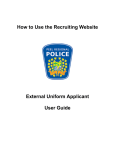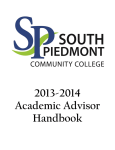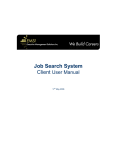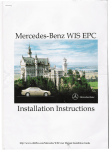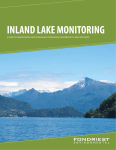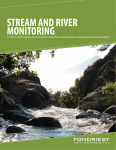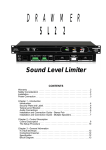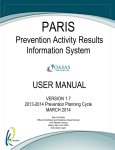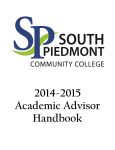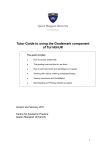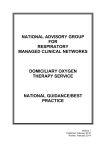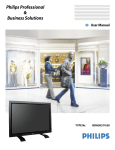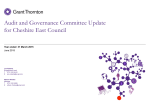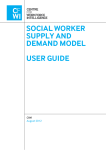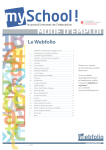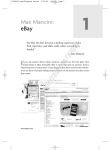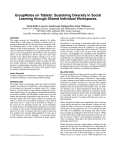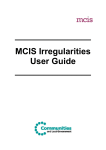Download Résumé Writing
Transcript
______________________________________________________________________________ Résumé Writing ______________________________________________________________________ What is a résumé? The purpose of a résumé is to get an interview. A résumé is like an advertisement: it must attract attention, create interest, and generate action on the part of the reader. A good résumé will lead an employer to call you to discuss at an interview how your background and personality fit the organization. Since the average employer takes less than one minute to scan a résumé, your résumé must be brief: no longer than two pages. The résumé tells a potential employer what you have done, what you can do, who you are, and what you know. It also states what kind of work you seek. The résumé must provide enough information to allow the employer to evaluate your qualifications and to convince the employer to invite you for an interview. The résumé is more concise than a curriculum vitae (CV), which is prepared for a teaching/research position at a university or for inclusion in an application package for graduate school. If you need help writing a CV, refer to careerservices.uwaterloo.ca. What do employers want? Content Design your résumé to match the position you seek: convey the skills and traits you would bring to the job. Be sure to demonstrate: • • • • Your Your Your Your relevant skills, knowledge, and experience personality, to ensure your compatibility with the work environment general interests ability to set and achieve goals Style and appearance Whether an electronic or paper version, your résumé should make a favourable first impression: include well-organized material, use an easy-to-read serif font (e.g., Times New Roman or Courier, 11-12 point size), check grammar and spelling, and provide up-to-date information. Minimize the use of tabs and highlighting techniques (e.g., bold, italics, capitals) so that your résumé does not look too "busy." Print your résumé on high-quality white or light neutral paper, and do not handwrite corrections or use whiteout. Write in a positive tone while describing your education, experience, skills, and qualities. Don't be shy! If you don’t believe in yourself, how will a potential employer believe in you? Nevertheless, the résumé must be an honest depiction of your experience and abilities. Don't lie or stretch the truth. Any misrepresentation will come back to haunt you— if not at the interview, then on the job. Copyright © 2005 Career Services, University of Waterloo There is no ideal résumé suitable to all job seekers. Your goal should be to create a document that reveals your strengths through both your content and your writing style. Be enthusiastic, confident, and focused. Major sections of a résumé It is up to you to determine which sections to include in your résumé. Job Objective and Summary of Qualifications are typically the first two. The remaining sections should be ordered according to their relevance to the job. If you have only one or two points to communicate under any section heading, consider including the information under an existing heading rather than creating a new one (e.g., include one or two awards as a subsection under Education). The content of the first page is especially important. An employer may initially spend just a minute or less looking over your résumé, so you should position the most important sections on the first page. Use key words that are common in the industry to which you are applying and/or that are listed in the job advertisement. Doing so will increase the chance of your résumé being selected during human or electronic scanning. Remember to include dates throughout your résumé. If you are concerned that the information in your résumé will reveal your ethnicity or religious, political, or sexual orientation, use generic terms (e.g., "Team Leader, Local Youth Group"). The following are possible sections and sub-sections of a résumé: Contact Information Contact Information refers to information such as name, address, telephone number, email address, and web page/blog. In North America, no other personal information (e.g., date of birth, marital status, or Social Insurance Number (SIN)) is required, nor are labels for each piece of information (e.g., "Email", "Résumé," or "Contact Information" at the top of the page). Co-op students should add their academic level, plan name, and student identification number. • • • • • • Include your name on both pages (in the largest heading on page one, using a font size larger than that used in the body) and the page number on page two If you will be changing address while your résumé is in circulation, note the expected date of your move (e.g., "address valid until April 18, 20xx") Decide what headings you will use if you need to state two addresses (e.g., Local/Present and Home/Permanent) When creating a personal email address, ensure that it is business-like; be selective when choosing an email provider because the addresses of some of the more popular ones are rejected by SPAM-filtering software If you cannot answer your phone during business hours, make sure you have a reliable message retrieval system with a professional-sounding recording, or list an alternate number in your résumé If you include a web page/blog, make sure it is professional and up-to-date. Your site can include your résumé and/or examples of your work (e.g., reports, projects, thesis, code, drawings, etc.) • • If you have no Canadian work experience and/or you may appear to be ineligible to work in Canada, note your citizenship as "Canadian Citizen" or "Permanent Resident" After graduation, foreign students may have opportunities to work in Canada temporarily. Decide whether you would like to include a notation about short-term employment on your résumé (e.g., "Available for one-year contract"). Check the usual employment requirements for the countries that interest you. Job Objective or Career Goal Job Objective often refers to an interim or relatively temporary role, whereas Career Goal refers to a longer-term position (e.g., "Forensic Chemist" for a career goal and "Summer Camp Counsellor" for a job objective). Listing an objective is optional on a résumé for coop, summer, or part-time employment; however, a recent survey of UW co-op employers indicated a preference for its inclusion. • • If the (e.g., If the (e.g., résumé is for an advertised position, include the job title in the statement "Junior Computer Programmer," "Social Worker," or "Technical Writer") résumé is for an unadvertised position, state an area or field of interest "Public Relations" or "Health Education") Summary of Qualifications or Skills Summary This section provides a concise overview of your qualifications, showing the employer how you will offer a competitive advantage. Qualifications may be drawn from any area of your life (e.g., work, volunteer experience, education, or other activities). Typically, include four to six points outlining your relevant strengths, beginning with the most relevant to the job. Points may begin with nouns or adjectives. Describe your competitive advantage—the value you offer. For example: • Three years process engineering experience with key responsibilities in product design and implementation All points in your Summary of Qualifications should be targeted to your potential employer, elaborated on throughout your résumé, and accurate. Employers indicate that job applicants often falsely claim to possess skills and that such misrepresentation is perceived negatively. Precision and accurate wording will help you obtain a job to which you are well-suited and in which you can excel. Your summary points must reflect the research and other work you have done. Consider including key words commonly used in the industry to which you are applying. If you are having trouble identifying what to highlight, do more research! Try typing "job description" + "computer engineer (or the title of the job you seek)" into a search engine to discover industry-specific words and phrases. Include: • • As a first bullet (if applicable), your work experience (paid or unpaid) relevant to the Job Objective (e.g., "one year experience in graphic design") Your relevant knowledge/skills/expertise (e.g., "computer proficiency, report writing, program planning, public speaking, problem-solving") • • • • • Any education that complements your practical experience (e.g., "machine design, resource assessment, marketing") A general reference to where you developed the skill (e.g., "proven leadership skills developed through three summers as camp counsellor"). Include this level of detail only once or twice so that points do not become too lengthy Personal characteristics and attitudes; however, include only those that are relevant to the position you are seeking (e.g., "able to work under pressure, consistently meet tight deadlines, attentive to detail, recognized for being flexible because of willingness to work weekends, holidays and evening shifts") Specialized training/education (e.g., "CPR certification") Fluency in a language other than English, specifically noting your level of verbal and/or written competency Education How you describe your education depends on your level of study and your graduation status. Consider the following options: • • • • • • • For students in postsecondary education: Candidate for, Degree, Plan (major)/minor/option/specialization (if desired), University, Location and Year beginning program (e.g., "Candidate for Bachelor of Mathematics, Honours Computer Science, University of Waterloo, Waterloo, Ontario, September 20xx – present") Secondary school listing: omit reference to your secondary school once you have moved beyond your first year of postsecondary study unless the reference is to a prestigious institution or will add valuable information when the reader considers you for an interview; list Diploma, High School, Location and Year diploma was received (e.g., "Ontario Secondary School Diploma, ABC High school, Any-town, Anyprovince, 20xx"); include specialization if applicable For alumni: Degree, Plan (major), University, Location and Year degree obtained (e.g., Bachelor of Arts, History, University of Waterloo, Waterloo, Ontario, June 20xx); omit reference to the month after the end of the year of graduation If you changed your program of study, include an entry like the following: o Candidate for Bachelor of Science, Honours Biology, University of Waterloo, Waterloo, Ontario, 20xx - Present o Environmental Studies, Geography, University of Waterloo, Waterloo, Ontario, 20xx - 20xx Check the name of the degree granted (e.g., Bachelor of Applied Science for most engineering students; Bachelor of Mathematics for computer science students), and list the degree unabbreviated Multiple entries: when referring to more than one program (e.g., Bachelor's, Master's), arrange entries in reverse chronological order (i.e., most recent first) Incorporate professional development activities (e.g., certification, workshops, or continuing or distance education courses) by changing the heading to "Education and Professional Development," arranging entries in reverse chronological order Relevant Courses Consider creating this section as a sub-heading or as a bullet point of the Education section. • Choose three to six courses related to your Job Objective • • • • If the name of the course does not convey its relevance, elaborate (e.g., "Basic Human Resources Management—trained in labour relations and various recruiting and salary negotiation techniques") Prioritize the list or arrange it by themes to prevent the appearance of randomness Place information in columns for easy reading, or separate courses with commas (if space is an issue) Do not include the course number Project(s) and/or Thesis You may choose to create this section as a sub-heading or as a bullet point under the Education section. • In italics, refer to any relevant project, report, thesis, etc. If the title does not indicate a project's scope and relevance, use a few words to describe it Laboratory Skills, Technical Skills, Scientific Instrumentation, Certification Consider creating one or more sections to highlight strengths in these areas. • • Present an overview of qualifications relating to your job objective If including dates, list them in reverse chronological order Work Experience How you format your work experience section depends upon the type of résumé you have chosen. Refer to Résumé styles and templates for details on the three types. Generally: • • • • • • • • • • This section could also be referred to as "Employment Experience" or "Relevant Work Experience" Include up to six points outlining your most relevant strengths List your points in decreasing order of importance for the type of work you are seeking (i.e., most relevant first) In point form, describe what you accomplished on the job Begin each point with an action verb; do not use weak verbs such as "helped" or "assisted" Use the present tense for ongoing jobs and the past tense for past jobs Do not use vague expressions such as "responsible for" or "duties included"; they often diminish clarity Describe the most relevant points in greater detail (e.g., in an entry about report writing, you would include information about literature searches only if that part of the experience was relevant to the job) If your work experience is not directly related, emphasize transferable skills (e.g., if you worked as a server and now want to work in an administrative role, emphasize your ability to work under pressure/stress, communicative/interpersonal skills, attention to detail, etc.) There is no rule concerning how recent an experience must be to be included on your résumé; if it is relevant, include it • • • If you learned something on the job (e.g., how to use a new piece of software) but did not have a chance to use it, you may include a "learned" statement (e.g., learned how to use Excel); use this approach sparingly Indicate your level of responsibility (e.g., "depositing cash" or "managing a department during the absence of supervisor") and provide evidence of promotion if applicable Do not use personal pronouns such as "my" and "their," or definite and indefinite articles: "a," "an," or "the" Awards and Scholarships • • • • State the name of the award, the name of the institution from which the award was received, and the date it was received Include important awards from both university and high school in reverse chronological order Explain the significance of the award if it is not implicit in the award's title Be selective; include no more than six entries Professional Memberships • List current and relevant memberships, and include dates to demonstrate length of membership Publications • • • List in bibliographic format only those publications that would interest the reader. If your list is lengthy, include only relevant publications, using the heading "Selected Publications.” If there is insufficient space to list all relevant publications, add "Additional publications available upon request" as part of a point or as a footer at the end of your résumé Include work that has been published, has been submitted for publication, or is in progress List papers or reports you presented as a guest speaker Languages If you are proficient in several languages and this skill is relevant, create a "Languages Spoken" section. • • List languages in which you are fluent (other than English) Specify your verbal and/or written competency level; take special care to be accurate in this section because some jobs require fluency Volunteer Experience Format volunteer experience according to the message you wish to convey. • If you wish to highlight two or more volunteer activities, create a separate heading (e.g., Volunteer Activities, Volunteer Experience, or Community Service) • • • • In this section, either list the organizations for which you volunteered or add detail about your contributions, beginning each point with an action verb Include your Volunteer Experience before Work Experience in your résumé if it is more relevant If your volunteer activities are as impressive as your paid work experience, add information on volunteering to your Work Experience section, with a notation (e.g., "Assistant to Director—volunteer") If your volunteer activities are not directly related to the work you are seeking, add them to the Activities and Interests section Activities and Interests • • • Begin by listing organized activities; state role (e.g., "Member," "President"), name of organization, location, and dates; organize entries in reverse chronological order; and state if you were elected or appointed to any positions General interests or hobbies do not require dates If you have many interests, consider including only those that are most relevant to the job to which you are applying (e.g., fitness-related interests for a job in a healthoriented field) References • • • • • Although references are very important, the notation “References Available Upon Request” is no longer considered necessary Generally, you should not list referees' names and contact information: your goal should be to meet with the prospective employer to sell yourself before the employer contacts your referees. In addition, you do not want your referees to have to answer phone calls until you have reached the interview stage. Always ask permission to use someone as a reference. Choose only people you are sure will speak highly of you. Be sure that they see your strengths and weaknesses as you see them, and discuss what your referee's response might be to potentially embarrassing questions. If much time has lapsed between requesting permission to use a reference and a potential call from an employer, notify your referee that a call may be forthcoming Choose someone who has seen you work in situations similar to those in which you would be working in the job to which you are applying; you do not need to use your immediate supervisor Give your referees a copy of the résumé(s) you have submitted to employers Have the names, addresses, and telephone numbers of two to four references on sheets that you can provide to an employer when asked for your references Writing effective bullet points Use bulleted statements throughout your résumé. Each bullet point should strongly communicate your qualifications and accomplishments which are relevant to the position. If you have only one bullet point in a section, find a way to incorporate it into another section. Review Major sections for advice on writing bulleted statements in Job Objective or Career Goal and Summary of Qualifications or Skills Summary. Any bullet point in the Work Experience, Volunteer Experience, Education, and Activities and Interests sections should begin with an action verb that will create a vivid image of your accomplishment. Be concise and avoid repeating verbs. Please refer to the list of action verbs (Appendix A) provided. Remember that all action verbs are not created equal! Verbs like "helped," "assisted," "participated," and "worked," although technically in the active voice, fail to provide a specific picture of what you have done, so avoid them them wherever possible. If you intend to use such words to show that your role was to participate in but not to lead a project, consider using other strategies. If you were one member of a two-person team, consider using "co-" as the prefix to the action verb describing your role (e.g., "Co-edited user's manual"); if you were part of a team with 2+ members, explain your role and end by indicating that others were involved (e.g., "Edited user's manual for XYZ software, as member of communications team," or "Edited user's manual for XYZ software, in collaboration with supervisor"). If, on the other hand, your goal is to hide the fact that your role was minimal, omit the statement. You may find it helpful to think of the following four components as you begin to write bulleted statements: 1. Skill: what action you took—action verb (e.g., "designed") 2. Task: ways in which you applied skills—using descriptors, adjectives, and nouns (e.g., "client database") 3. Tools: how you performed the task—attitude conveyed, hardware/software, or process used (e.g., "MS Access") 4. Result: what outcome you achieved—quantified wherever possible (e.g., "doubled speed of information retrieval") Complete statement: Designed client database using MS Access; doubled speed of information retrieval Although each bullet point should include skill and task components, always adding tools and results may be too lengthy. Try to include points that use three or all four components several times throughout your résumé, especially when demonstrating key achievements. Résumé styles and templates There are three basic types of résumés: chronological, modified chronological, and functional. The decision to use a particular style depends upon your past work experience and your current objective. Chronological résumé • • The chronological style is the most common. Since employers are most comfortable with this format, choose another format only if the chronological résumé does not allow you to market your skills effectively Organize jobs in reverse chronological order, stating: o Job Title: create an accurate one if you had none o Name of company or organization and location (city/province). Do not include supervisor's name or employer's street address or telephone number Dates, beginning and terminating (for full-time, on-going positions of at least one year, it is not necessary to include a reference to the months) For jobs you want to include but not in detail, add a sub-section at the end of Work Experience called Other Work Experience (dates if you wish, e.g., 20__ - __) with job titles, or job titles and type of work environment if helpful (e.g., camp counsellor, waiter in fast-paced truck stop, stock clerk in automotive store) If you started or ran your own business, refer to it by its proper name and your official title. For example, you could write: o Owner/Manager, ABC Window Cleaning, Toronto, Ontario or o Proprietor, Residential Window Cleaning Service, Toronto, Ontario o • • • Chronological template (Appendix C) Modified chronological résumé • • • • • • • The difference between this type of résumé and the chronological one is the section on work experience The modified chronological résumé enables you to feature related experience, or to move to the top of the section those jobs that would ordinarily be listed after less relevant ones Replace the words "Work Experience" with a description about the type of experience; be consistent—use either all nouns or all adjectives; see Sample experience headings (Appendix B) for examples Collect in one section all jobs of similar type and list them in reverse chronological order Write in the past tense for former positions and present tense for current positions Be sure that the theme word you use to describe each Experience section is descriptive of aspects of the job you stated in your objective Modified Chronological template (Appendix D) Functional résumé • • • • • The difference between this type of résumé and the chronological one is the section on work experience A functional format may be useful for individuals who have: o Little or no related experience, but do have relevant qualifications for the job o Relevant experience, but these positions would be lost among the other jobs in a chronological résumé and the modified chronological format would not be suitable o A number of similar work experiences, which would require repeating the same points under several job listings o So much material to say that it would take more than two pages to do it It is essential that you have a good chronological résumé from which to work because it is difficult to think creatively and evaluate information at the same time Identify three to six major skill areas related to your objective; be consistent—use either all nouns or all adjectives; see Sample experience headings (Appendix B) for examples Make sure there is no overlap in meaning when selecting the names for your skill sections; as you take each point from your chronological résumé, you will then find that it clearly fits in only one section • • • • • • Take each point in the job description section of Work Experience from your chronological résumé and include it under one of the skill headings you created; ensure that each point starts with an appropriate action verb Since the points are removed from the employers they were associated with, you may have to add some generic information on setting, population, etc.; example: under ABC Parks and Recreation Department in your chronological résumé you have "organized Friday afternoon drop-in leisure activities for seniors"; in your functional résumé, add "in a recreational setting" so that the reader will not wonder in what context (medical, psychological, etc.) Try to combine points whenever possible to make clear, concise entries; the number of points for each function/skill should range from three to seven In formulating the points for each thematic qualification, you can also draw upon your academics (projects, papers, etc.), extracurricular activities, and volunteer work as long as the reader knows the setting and does not think you have done the work in one of your paid positions The Work History section comprises, in reverse chronological order, a listing of your employment: Job title, Company/Organization, Location, and Date. There are no job description details in this section Functional template (Appendix E) Proofreading Before you give your résumé to any potential employer, proofread it carefully and have at least one other person review your copy. Your computer's spell checker will catch some typing and spelling errors, but it will not point out words that have been correctly spelled but incorrectly used (e.g., "precious" when you meant "previous"). In addition, pay attention to the following: • • • • • Appearance: At first glance, will the employer find the résumé attractive and want to read it (attractive paper weight/colour, layout of sections/points/margins, font size/style; smooth paper; no corrections in handwriting, etc.)? Accomplishments: Does the document present your qualifications from both theoretical and practical perspectives and cover education, skills, experience, personality, etc? Writing/presentation: Is each point relevant to the job to which you are applying? Is your writing clear, concise, and complete? Are your words precise and actionoriented? Are there any spelling, typographic, or grammatical errors? Sales appeal: Have you told readers in a positive, interesting way what you can do for their organization and provided enough proof of expertise that the reader will want to interview you? Contact information: Have you provided your name, street/e-mail address(es), voice/fax numbers, and website/blog address on the top of page one so that an employer can easily reach you? Electronic résumés Changes in technology have changed the recruitment process significantly over the past decade. Today, most companies accept or request an electronic version of your cover letter and résumé. Résumés are sorted and stored in various ways by human resource departments, using databases that organize application packages into categories. There are five methods by which you may be asked to submit your cover letter and résumé: 1. Inside the body of an email, using ASCII (American Standard Code for Information Interchange) text format 2. Attached as an MS Word document or PDF (Portable Document Format) file 3. Copied and pasted to an online application form, using ASCII text format 4. Online in HTML (HyperText Markup Language) format 5. Multimedia format Sending the résumé in ASCII text format ASCII text, also known as plain text format, is a worldwide standard that allows computers to exchange information files and documents. Regardless of what operating system you use (e.g., Windows, Linux, Unix, or Macintosh), you can transmit or receive ASCII text. This technology is used for internet communications, including email. It is also the format in which employers and job boards have you build online résumés. Note: The following advice also applies to ASCII text cover letters. Writing an ASCII text résumé • • • • • • • Word process your résumé To convert the file into ASCII, select File, then Save As in the menu bar In the File Name box, consider saving your attachment as your first and last name (e.g., Jane_Doe_Application). This naming convention will help the organization sort your information In the Save As Type box, choose Plain Text (*.txt) A pop-up box will appear, warning you that saving the document as a text file will cause all formatting, pictures, and objects to be lost. Click Ok to have your document converted automatically Close and then reopen the document to view the conversion Keep a copy of your résumé in ASCII text format as a separate file from your word processed copy Formatting an ASCII text résumé • • • Proofread and correct your ASCII text résumé to ensure that it is presentable The font will automatically be converted to Courier New, but you must change the font size from 10 points to 11 points or larger Special formatting (e.g., bolding, bullets, tabs, italics, graphics, shading, lines, borders, and underlining) will not be recognized; consider using the following instead: o Capital letters or asterisks surrounding font in place of bolding o Dashes in place of horizontal lines, or spaces between headings to separate sections of your résumé • • • • • • o Asterisks (*), plus signs (+), or arrows (<) in place of bullets ASCII text automatically left justifies, so indent using the space bar instead of tabs Substitute spaces (five is standard) for indentations so documents will be symmetrical Indicate the end of a line by using a hard return (i.e., Enter) to ensure correct appearance (no wrapping) Include 60 to 80 characters per line and set page margins at 2'' Do not centre text: most database systems will not support this feature Insert page breaks between your pages to prevent the appearance of unwanted spacing between your pages, sections, and/or headings. Sending an ASCII text résumé in the body of an email • • • • When submitting your résumé over the Web, always copy from your ASCII text file because it will be properly formatted for electronic submission Open your text résumé document, highlight the entire document, and click Copy Paste it directly into the message area of your email Begin the email with your ASCII text cover letter, unless requested not to do so by the employer Sending the résumé as an email attachment • • • • • Click on Attachments in your email system In the Go To section, click Browse (or Look In) Find the file in which your plain text or PDF document is located Click on this file and then press Ok or Attach Your file should show up on your email as an attachment Because of the prevalence of viruses, many organizations will not open attachments. Unless otherwise directed by the employer, submit both an ASCII text document within the body of the email and an MS Word or PDF file attachment, leaving the employer to choose which version to view. Emailing a PDF file is an increasingly popular alternative to attaching an MS Word document. However, to view your résumé, employers need to have Adobe Acrobat Reader software installed on their computers. If you choose this method of delivery, contact the organization or recipient beforehand to determine which delivery formats are supported. When emailing attachments, combine the cover letter and résumé into one document because opening or viewing two windows can be frustrating for the employer. Consider including a line stating the purpose of your email and that the attachment has been checked by anti-virus software. Regardless of the format used, ensure that the subject line includes the job title and a job number or code, if one has been provided. Sending the résumé in ASCII text format to an online application form • • Always copy your résumé from your ASCII text file when submitting your résumé online Highlight and Copy all text in your résumé document • • Go into the online application form and Paste your document directly into the appropriate location Paste your ASCII text cover letter if asked to do so by the employer Often, you will have the option to post your ASCII text cover letter and résumé online to company sites, eNetworking groups, job banks, employment placement services, and other forums. To submit your application to a database, you may be requested to follow a particular process, which may include: • • • Registering with the site by completing all necessary fields, including contact, geographic, and demographic information (e.g., name, address, etc.) Responding to general questions to see if your background makes you a good fit for the organization Obtaining an userid and password to access site information and update your profile (e.g., make changes to your résumé or request email job alerts) Ensure that you read each company's instructions and information carefully. Employers want to ensure that you can follow directions; for example, if they ask you to answer a question in twenty words or fewer and your response exceeds the limit, you may be automatically eliminated from their database. Employers may not ask that you include the Skills Summary or Highlights of Qualifications sections of your résumé on the application form. In this case, you can simply include the information from these sections in the "comments" or "additional information" fields. In these fields, you might also demonstrate your knowledge of the company to indicate your interest in the organization. Before submitting your résumé online, read each site's privacy and confidentiality agreement. In addition, ask yourself: • • • • • • Am I comfortable with the site's privacy and confidentiality policies? Whom do I want to see my résumé? Do I want it to be a private or a public document? How often do I need to update my profile/résumé for it to be refreshed within the site's database? How long will my résumé be kept in the database? Can I resubmit once that time has expired? Can I update my résumé easily and at no charge? Why am I posting online? (Online posting is a great option to supplement your job search, but do not use it as your only method.) Online in a HTML format You can market your résumé by posting it on your personal website, using HTML format (the language used by the web browser to show web content). HTML formatting is relatively simple to learn through online tutorials. You can also build your website using any HTML editor (e.g., MS FrontPage). Editors are similar to word processing programs. One disadvantage of promoting résumés this way, however, is that your document may not be viewed in its intended format if the browser or browser settings used by the viewer differ from yours. Before displaying your résumé to employers and network contacts, follow these guidelines: • • • Ensure that your website is professional and contains no information that could reduce your chances of obtaining employment Proofread your code, and edit it if necessary Review your résumé in various browsers to make sure it is understandable and pleasing to the eye. Check font size/style, bullets, colour, alignment, table formatting, screen display, etc. Consider ways to present your résumé effectively. Include your site address (URL) within the contact information of your cover letter and/or résumé, calling card, and portfolio. Refer to your online résumé in any formal or informal meeting/interview to generate interest and make yourself stand out from the competition. Multimedia format Multimedia (also known as Flash) résumés or ePortfolios are most often created on CD or on a webpage and incorporate graphics, video, color, sounds, photographs, special fonts, links to research papers/projects, and animation. They are a unique way of marketing your skills and background. Many online companies will help you create your own, mostly on a fee-forservices basis. Although such résumés are becoming more common, if you choose to use this type of résumé, remember that some employers may not have the equipment necessary to download your résumé properly, or at all. Research the potential employer's preferences and capabilities before using this type of résumé. This format may be most helpful in certain fields (e.g., acting, graphic design, and advertising). Follow-up After responding to an online job posting, you should usually follow up, either by phone or email, with the contact person listed on the job advertisement. If there is no contact information, phone the organization to determine whom to contact. Do not follow up, however, if the employer clearly states "No phone calls, please." Appendix A Action verbs Describe your skills using action verbs. Review these sample verbs and select those that apply to you. achieved acted adapted addressed adjusted administered advised altered analyzed appraised arbitrated arranged assembled assessed associated audited balanced broadened budgeted built calculated calibrated catalogued categorized chaired classified coordinated coached collected combined communicated compared compiled completed composed computed conducted configured consolidated constructed contracted contrasted controlled converted corrected corresponded counselled created critiqued decided decreased defined delegated delivered demonstrated described designed determined developed devised diagnosed directed discovered dispensed displayed dissected distributed documented doubled drafted drew edited eliminated encouraged enforced engineered enhanced enlarged ensured established estimated evaluated examined expanded expedited explained expressed fabricated facilitated financed finalized fixed forecasted formulated founded generated guided monitored motivated hired hosted narrated navigated negotiated identified illustrated implemented improved improvised incorporated increased informed initiated inspected installed instituted instructed integrated interpreted interviewed introduced invented investigated itemized joined judged launched led learned lectured liaised listed located maintained managed marked marketed measured mediated minimized modelled moderated modernized modified observed obtained ordered organized oriented performed persuaded piloted planned predicted prepared prescribed presented produced programmed projected promoted proofread proposed protected provided publicized published purchased raised received recommended reconciled recorded recruited redesigned reduced referred refined rehabilitated rendered reorganized repaired reported represented researched resolved restored restructured retrieved reviewed revised revitalized saved scheduled searched secured serviced selected separated served shaped shared simplified sketched sold saved scheduled searched secured serviced selected separated served shaped shared simplified sketched sold solved specified spoke started streamlined strengthened summarized supervised supplied talked taught tended tested traced trained transcribed transformed translated travelled treated trimmed troubleshot tutored uncovered unified updated upgraded utilized validated verified viewed vitalized visualized weighed welded widened won wrote Appendix B Sample experience headings The following skill areas can be used as headings in the experience portion of a functional and modified chronological résumé. These are suggestions only; you may use many other headings, as well. Administration Advising Analysis and Evaluation Financial Analysis Food Preparation Fundraising Quality Control Business Development Business Management Health and Safety Human Resources Management Childcare Client Relations Communications Community Liaison Computer Experience Conflict Resolution Consulting Counselling and Development Creativity and Design Crisis Evaluation and Response Customer Relations Customer Service International Experience Sales and Marketing Special Events Coordination Strategic Planning Supervision and Training Systems Development Data Collection/Entry Design and Development Electronics Knowledge Equipment Operation Evaluation/Analysis Leadership Management Mentoring Office Administration Organizational Development Planning Presentation Skills Problem Solving Product Development Program Development Program Planning Programming and Special Events Project Management Public Relations Public Speaking Research Teaching Team Work Technical Skills Training and Development Trouble Shooting Warehouse/Inventory Writing and Editing Writing and Presentation Appendix C Chronological template NAME Academic Level (e.g., 1B) and Plan Name (co-op résumé only) University of Waterloo ID# (co-op résumé only) Local Address Street Address City, Province and Postal Code Phone Number Web site Email Cell Phone Number Permanent Address Street Address City, Province and Postal Code Phone Number JOB OBJECTIVE (optional for co-op résumé) • Title of position applying for or area of work SUMMARY OF QUALIFICATIONS (or SKILLS SUMMARY) • • • • • Number of years experience in relevant paid or unpaid work Related special knowledge, training or certification Relevant accomplishment/skill/attribute Relevant accomplishment/skill/attribute Relevant accomplishment/skill/attribute EDUCATION (or section most related to work being sought) Candidate for Degree Name (remove “Candidate for” if completed) Plan, Specialization/Option, Institution, City, Province, Start date - present (or completion date) • • • • Relevant Courses (3 - 6 related to objective listed by course name (not number)): Relevant Projects: Thesis: Awards (if not creating separate section): Other Diplomas (including secondary school if in 1st year of post-secondary studies)/certificates/training, listed as above with locations and dates WORK EXPERIENCE (or section 2nd most related to work being sought) Most Recent Job Title Organization, City, Province, Month/Year - Month/Year • • An accomplishment/statement relevant to job objective, preferably detailing unique actions and benefits to organization, beginning with action verb An accomplishment/statement relevant to job objective, preferably detailing unique actions and benefits to organization, beginning with action verb Name p. 2 WORK EXPERIENCE cont’d 2nd Most Recent Job Title Organization, City, Province, Month/Year - Month/Year • • • An accomplishment/statement relevant to job objective, preferably detailing unique actions and benefits to organization, beginning with action verb An accomplishment/statement relevant to job objective, preferably detailing unique actions and benefits to organization, beginning with action verb An accomplishment/statement relevant to job objective, preferably detailing unique actions and benefits to organization, beginning with action verb VOLUNTEER EXPERIENCE (unless including in Work Experience or Activities & Interests) Title Organization, City, Province, Month/Year - Month/Year • • • An accomplishment/statement relevant to job objective, preferably detailing unique actions and benefits to organization, beginning with action verb An accomplishment/statement relevant to job objective, preferably detailing unique actions and benefits to organization, beginning with action verb An accomplishment/statement relevant to job objective, preferably detailing unique actions and benefits to organization, beginning with action verb OTHER SECTIONS (e.g., Publications, Memberships) ACTIVITIES & INTERESTS Most Recent Position Held Club/Organization/Team, City, Province, Month/Year - Month/Year • If desired, an accomplishment/statement relevant to job objective, preferably detailing unique actions and benefits to organization, beginning with action verb 2nd Most Recent Position Held Club/Organization/Team, City, Province, Month/Year - Month/Year • If desired, an accomplishment/statement relevant to job objective, preferably detailing unique actions and benefits to organization, beginning with action verb List of activities/hobbies separated by commas (no dates necessary) Appendix D Modified Chronological template NAME Academic Level (e.g., 1B) and Plan Name (co-op résumé only) University of Waterloo ID# (co-op résumé only) Local Address Street Address City, Province and Postal Code Phone Number Web site Email Cell Phone Number Permanent Address Street Address City, Province and Postal Code Phone Number JOB OBJECTIVE (optional for co-op résumé) • Title of position applying for or area of work SUMMARY OF QUALIFICATIONS (or SKILLS SUMMARY) • • • • Number of years experience in relevant paid or unpaid work Related special knowledge, training or certification Relevant accomplishment/skill/attribute Relevant accomplishment/skill/attribute EDUCATION (or section most related to work being sought) Candidate for Degree Name (remove “Candidate for” if completed) Plan, Specialization/Option, Institution, City, Province, Start date - present (or completion date) • • • • Relevant Courses (3 - 6 related to objective listed by course name (not number)): Relevant Projects: Thesis: Awards (if not creating separate section): Other Diplomas (including secondary school if in 1st year of post-secondary studies)/certificates/training, listed as above with locations and dates XXX EXPERIENCE or SKILL (heading reflecting type(s) of work that will be described, relevant to job objective) Job Title Organization, City, Province, Month/Year - Month/Year • • • An accomplishment/statement relevant to job objective, preferably detailing unique actions and benefits to organization, beginning with action verb An accomplishment/statement relevant to job objective, preferably detailing unique actions and benefits to organization, beginning with action verb An accomplishment/statement relevant to job objective, preferably detailing unique actions and benefits to organization, beginning with action verb Name p. 2 YYY EXPERIENCE or SKILL (heading reflecting type(s) of work that will be described, relevant to job objective) Most Recent Job Title Organization, City, Province, Month/Year - Month/Year • • • An accomplishment/statement relevant to job objective, preferably detailing unique actions and benefits to organization, beginning with action verb An accomplishment/statement relevant to job objective, preferably detailing unique actions and benefits to organization, beginning with action verb An accomplishment/statement relevant to job objective, preferably detailing unique actions and benefits to organization, beginning with action verb 2nd Most Recent Job Title Organization, City, Province, Month/Year - Month/Year • • • An accomplishment/statement relevant to job objective, preferably detailing unique actions and benefits to organization, beginning with action verb An accomplishment/statement relevant to job objective, preferably detailing unique actions and benefits to organization, beginning with action verb An accomplishment/statement relevant to job objective, preferably detailing unique actions and benefits to organization, beginning with action verb VOLUNTEER EXPERIENCE (unless including in XXX/YYY Experience or Activities & Interests) Title Organization, City, Province, Month/Year - Month/Year • • An accomplishment/statement relevant to job objective, preferably detailing unique actions and benefits to organization, beginning with action verb An accomplishment/statement relevant to job objective, preferably detailing unique actions and benefits to organization, beginning with action verb OTHER SECTIONS (e.g., Publications, Memberships) ACTIVITIES & INTERESTS Most Recent Position Held Club/Organization/Team, City, Province, Month/Year - Month/Year • If desired, an accomplishment/statement relevant to job objective, preferably detailing unique actions and benefits to organization, beginning with action verb nd 2 Most Recent Position Held Club/Organization/Team, City, Province, Month/Year - Month/Year • If desired, an accomplishment/statement relevant to job objective, preferably detailing unique actions and benefits to organization, beginning with action verb List of activities/hobbies separated by commas (no dates necessary) Appendix E Functional template NAME Academic Level (e.g., 1B) and Plan Name (co-op résumé only) University of Waterloo ID# (co-op résumé only) Local Address Street Address City, Province and Postal Code Phone Number Web site Email Cell Phone Number Permanent Address Street Address City, Province and Postal Code Phone Number JOB OBJECTIVE (optional for co-op résumé) • Title of position applying for or area of work SUMMARY OF QUALIFICATIONS (or SKILLS SUMMARY) • • • • • Number of years experience in relevant paid or unpaid work Related special knowledge, training or certification Relevant accomplishment/skill/attribute Relevant accomplishment/skill/attribute Relevant accomplishment/skill/attribute EDUCATION (or section most related to work being sought) Candidate for Degree Name (remove “Candidate for” if completed) Plan, Specialization/Option, Institution, City, Province, Start date - present (or completion date) • • • • Relevant Courses (3 - 6 related to objective listed by course name (not number)): Relevant Projects: Thesis: Awards (if not creating separate section): Other Diplomas (including secondary school if in 1st year of post-secondary studies)/certificates/training, listed as above with locations and dates XXX EXPERIENCE or SKILL (heading reflecting type(s) of work that will be described, relevant to job objective) • • An accomplishment/statement relevant to job objective, preferably detailing unique actions and benefits, beginning with action verb, taken from paid or unpaid work/academic or life experience An accomplishment/statement relevant to job objective, preferably detailing unique actions and benefits, beginning with action verb, taken from paid or unpaid work/academic or life experience Name p. 2 XXX EXPERIENCE or SKILL cont’d • An accomplishment/statement relevant to job objective, preferably detailing unique actions and benefits, beginning with action verb, taken from paid or unpaid work/academic or life experience YYY EXPERIENCE or SKILL (heading reflecting type(s) of work that will be described, relevant to job objective) • • • An accomplishment/statement relevant to job objective, preferably detailing unique actions and benefits, beginning with action verb, taken from paid or unpaid work/academic or life experience An accomplishment/statement relevant to job objective, preferably detailing unique actions and benefits, beginning with action verb, taken from paid or unpaid work/academic or life experience An accomplishment/statement relevant to job objective, preferably detailing unique actions and benefits, beginning with action verb, taken from paid or unpaid work/academic or life experience WORK HISTORY (full time, part time, volunteer, etc.) Most Recent Title, Organization, City, Province, Month/Year - Month/Year 2nd Most Recent Title (Volunteer), Organization, City, Province, Month/Year - Month/Year 3rd Most Recent Title (Part-time), Organization, City, Province, Month/Year - Month/Year 4th Most Recent Title, Organization, City, Province, Month/Year - Month/Year OTHER SECTIONS (e.g., Publications, Memberships) ACTIVITIES & INTERESTS Most Recent Position Held Club/Organization/Team, City, Province, Month/Year - Month/Year • If desired, an accomplishment/statement relevant to job objective, preferably detailing unique actions and benefits to organization, beginning with action verb 2nd Most Recent Position Held Club/Organization/Team, City, Province, Month/Year - Month/Year • If desired, an accomplishment/statement relevant to job objective, preferably detailing unique actions and benefits to organization, beginning with action verb List of activities/hobbies separated by commas (no dates necessary)






















